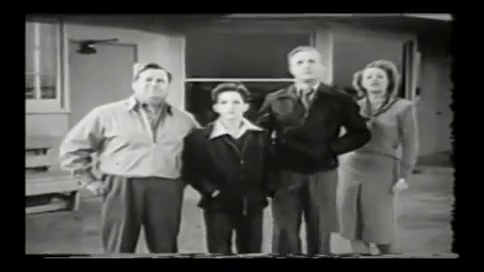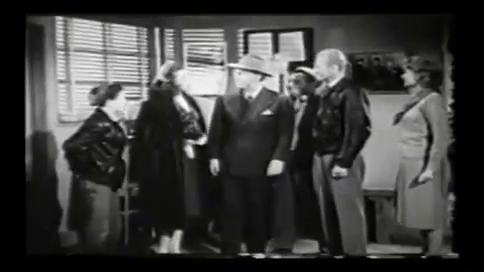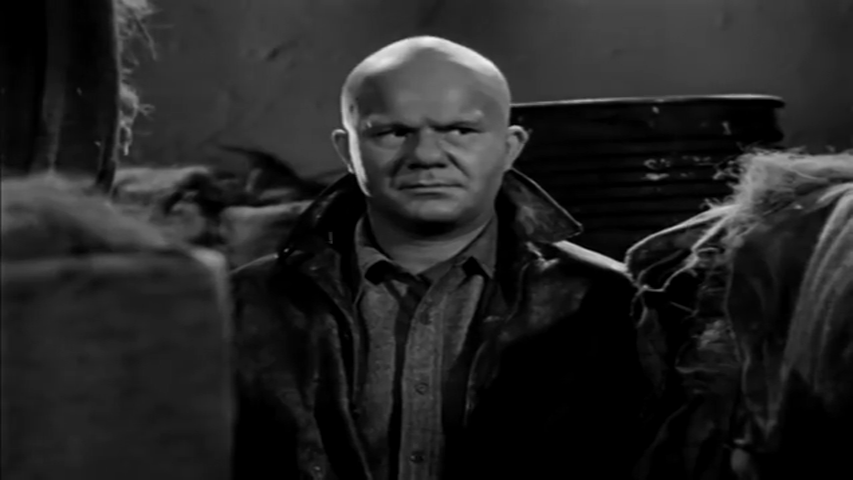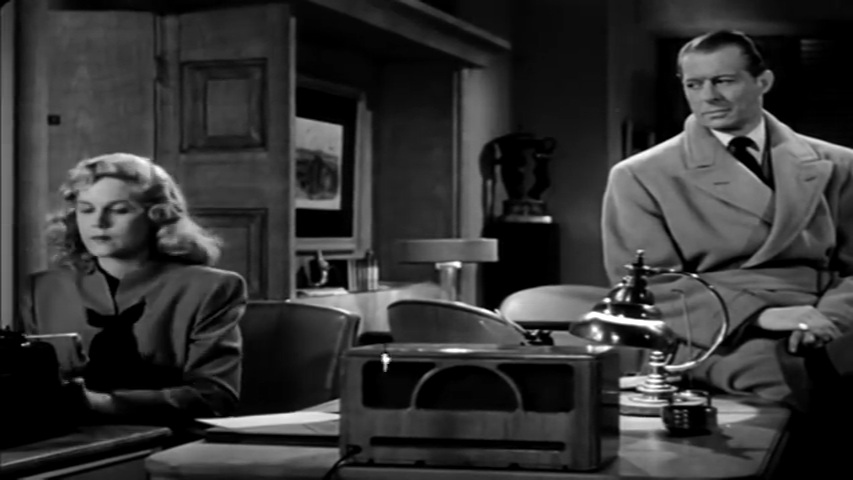-
#429 – The Mysterious Mr. M (1946)
The Mysterious Mr. M (1946)
Film review #429
Directors: Lewis D. Collins, Vernon Keays
SYNOPSIS: Anthony Waldren has assumed the identity of Mr M in order to steal the invention of a revolutionary submarine engine, undertaking a series of murders to do so, and using a new drug he has invented that can hypnotise people into doing his bidding. However, a person claiming to be the real Mr M contacts Waldren and starts giving him orders under the threat of exposing his crimes. Federal agent Grant Farrell, whose brother is one of Waldren’s victims, takes up the case of stopping Mr M, aided by fellow agent Kirby Walsh and insurance investigator Shirley Clinton.
THOUGHTS/ANALYSIS: The Mysterious Mr. M is a 1946 serial comprised of thirteen chapters. It is the 137th, and final serial that Universal Pictures ever produced. The other two big serial producers (Republic and Columbia Pictures) would produce serials for a few more years. The story of Universal’s swansong serial centres around Anthony Waldren, who attempts to steal Dr. Kittridge’s invention: A submarine engine that is far faster than anything currently in operation, Following a series of murders, someone claiming to be the real Mr M begins sending Waldren phonograph records outlining instructions for getting a hold of the blueprints for himself, forcing Waldren to work for him lest he expose his scheme. Federal agent Grant Farrell is assigned to stop Mr M and prevent the submarine engine from falling into the wrong hands. The premise sounds simple enough, and similar to a lot of other serials, but the main problem with the story is just how convoluted it becomes. Waldren, who faked his own death years before, uses the “Mr M” identity to undertake his crimes, until the “real” Mr M starts to blackmail him to follow his orders. His Sister also secretly works with him to cash in on their grandmother’s insurance policies, who works with insurance investigator Shirley Clinton, who also teams up with Grant Farrell, the federal agent and protagonist who is out to stop Mr M. All of these connections make the plot incomprehensible to follow at points, and simply doesn’t make very interesting viewing. The best serials are simple to follow, with heroes vs villains battling it out, but with enough space for imagination to make them more interesting. In The Mysterious Mr M, there is a severe lack of the latter, as most scenes consist of men in suits engaging in dialogue that explains the plot, and even then, it’s still difficult to follow. The plot involving a submarine engine seems entirely without consequence, as we don’t even see a submarine until the very last minute.
As mentioned, the web of character relations is convoluted and difficult to follow, without adding anything of value to the story. The identity of Mr M is kept secret until the last chapter as usual, and doesn’t really offer anything of consequence. The rest of the cast are rather dull and forgettable, with no real unique qualities, and it’s really not worth going through them. In adding all of these character relations, the serial simply forgets to make any of them interesting. The cliffhangers are also fairly standard, while using model buildings and vehicles to create huge explosions or crashes. They are always resolved, however, by having the heroes walk away with nothing more than a sore head or dizziness. The setups are very repetitive for each chapter, as plot and counter-plot between the heroes and villains gets tiring quickly. The only one which is mildly interesting is the heroes following a hidden tracking device on a map which resembles modern day GPS, which would have been more interesting and novel at the time.
Given that this is Universal Pictures final serial, it can safely be said that they ended on a whimper rather than a bang. The studio that gave us Flash Gordon had clearly run out of steam at this point. With the advent of television, perhaps Universal foresaw that viewers would not want to go to the cinema every week for twenty minutes when the format could be accomplished without such effort in their living rooms. After the second world war, the serial format of heroes fighting spies and villains working for foreign powers undoubtedly became dramatically less relevant, and people probably wanted to see something different. Columbia and Republic Pictures continued producing serials that featured military heroes that celebrated the military victories in the war, and also returning to some more sci-fi settings that popular serials had before the war, but The Mysterious Mr. M offers none of that; it offers very little of anything in fact. It’s a sad end for Universal’s serial producing machine that, while guilty of rehashing the same stories and characters for over ten years and over a hundred serials, undoubtedly entertained viewers and sparked the imaginations of young moviegoers. The Mysterious Mr M seems unsure what to do in the post-war era without big foreign enemies or looming war to provide the backdrop for it’s story. Regardless, there’s no excuse for the severe lack of imagination in the settings or characters, and the boring dialogue that re-explains the plot constantly, and even then fails to make it make sense. A momentous occasion in the history of the serial format, but one ultimately that is best forgotten.
-
#410 – Hop Harrigan (1946)
Hop Harrigan (1946)
Film review #410
Director: Derwin Abrahams
SYNOPSIS: Hop Harrigan, a pilot along with his buddy “Tank” Tinker, are hired to escort a scientist to his secret laboratory hidden in the mountains, where he is working on a powerful new source of energy. Meanwhile, a man known only as the “Chief Pilot” is after the invention for himself to use as a deadly weapon. Hop and his friends are caught up in the schemes of all of these players, and they must stop them before disaster befalls the world…
THOUGHTS/ANALYSIS: Hop Harrigan is a 1947 movie serial based on the Hop Harrigan character from the All-American Comics series, as well as the radio plays. Harrigan became quite popular during the course of the second World War, probably due to his heroic piloting antics which would have resonated with the population. However, his population waned after the war ended along with many of the similar characters, with people rather turning their attention to costumed superheroes and the villains being spies rather than soldiers. The serial starts off with Hop performing a mid-air rescue, then returning back to the airfield where he works. he is offered a job by a man named Arnold to fly a scientist named Dr. Tobor to his secret laboratory. Tobor has been working on an invention that runs on a powerful new energy, and has to keep Hop and Tank blindfolded while in the air so they do not see where the lab is. Meanwhile, an unknown person calling himself “The Chief Pilot” is intent on getting a hold of Tobor’s invention for himself, and sends his goons to kidnap him. The plot of the serial as always follows the standard format of each chapter having a different scheme or plot to foil, with it ending on a cliffhanger for the next chapter. I imagine the serial format isn’t the best one to adapt Hop Harrigan in, as he is probably more used to dealing with soldiers and villains rather than engaging in thwarting espionage, but again that’s like a lot of the serials, which used the name of a comic book character and didn’t really adapt anything else about them.
On the heroes side, you have the standard All-American heroics of Hop Harrigan, his sidekick and comic relief “Tank”, who offers some decent interactions with his goofiness playing off against other characters. Gail is the token female character who runs the airfield (though she doesn’t really do much), and her younger brother Jackie, whose book-smarts often clash with Tank’s brute-force approach. Jackie provides a good example of a younger characters which the kids in the audience can relate too, and he has a decent amount to do, which helps in that regard. Other than that though, the heroes are pretty unremarkable. There are quite a few villains in this serial, ranging from the mysterious Chief Pilot, whose identity isn’t revealed until the end (a typical serial trope), and an array of henchman, some of whom are working with the Chief Pilot, and some who are working for Hop’s employer Arnold and secretly working against him. There’s also Dr. Tobor (’Robot’ spelled backwards in case you hadn’t noticed; I’m pretty sure I’ve watched another serial or film which uses the same name, but I can’t remember which), who essentially plays the eccentric scientist who becomes more and more erratic as the serial progresses. He is sought by both heroes and villains, and constantly tricks them and plays them for fools, which shakes up the dynamic. Tobor as the wildcard element helps to give a bit of an original edge to the story, and that is welcome.
If you’re going to watch a Hop Harrigan serial, then no doubt you’ll be expecting plenty of scenes in the sky and plane fights. The serial more or less delivers what it promises with plenty of scenes taking place in the air, and shot reasonably well for the time, but most of the action does take place on the ground, and the plane scenes are just to travel from place to place, or to follow a car from the air.
-
#391 – Dick Tracy vs. Cueball (1946)
Dick Tracy vs. Cueball (1946)
Film review #391
Director: Gordon M. Douglas
SYNOPSIS: Police detective Dick Tracy is called to a murder scene on board a ship where a jeweller has been strangled and a valuable set of diamonds has been stolen. As he continues to investigate, he uncovers a conspiracy involving multiple people to sell the diamonds, and must apprehend the man known as Cueball, who is killing off the people involved…
THOUGHTS/ANALYSIS: Dick Tracy vs. Cueball is a 1946 crime-noir film and the second Dick Tracy feature film. As the film opens, we see a boat docking into port when a thief breaks into a jeweller’s cabin, killing him and stealing the diamonds. Dick Tracy is called out to investigate the murder, and suspects a much larger conspiracy to re-cut and sell the diamonds. The story follows the investigation through all its twists and turns, and it is a story that is easy enough to follow while having enough interesting developments to keep one’s interest. At just over sixty minutes, it is not a long film, but it still feels full of content along with offering a complete experience. There’s not too much else to say different than what I wrote for the review for the previous film: its’s more of the same, mixing comic book characters with the crime-noir setting resulting in an easy to follow story, but an entertaining one at the least. Unlike its predecessor though, this one feels a little more down to earth, without the odd mystical elements that didn’t quite belong or go anywhere.
The protagonists from the first film all return, and as there, each of them feel a little like the comic book characters they are based on. The various suspects too have their own particular appearances and personalities, and it’s fun watching them all interact with each other. Everybody has something going on or a role to play, and no one feels wasted. The main antagonist, Cueball, definitely feels very menacing, and a genuine threat throughout, made even more menacing by the use of lighting throughout in typical crime-noir fashion. Tracy’s assistant Pat Patton provides a bit of comic relief, along with the young Junior, and Tracy’s girlfriend Tess Trueheart also gets a role to play in the investigation. Overall, Dick Tracy vs. Cueball is very similar to its predecessor released in the previous year, but also manages to make some improvements by tightening the story, making it flow better, and making the villains more menacing. It’s not an exemplary example of the crime-noir genre, but it’s a good combination of it with the comic strip characters and personalities that gives it a bit of a unique flair. If you enjoyed the first one, you will certainly enjoy this one too.





























